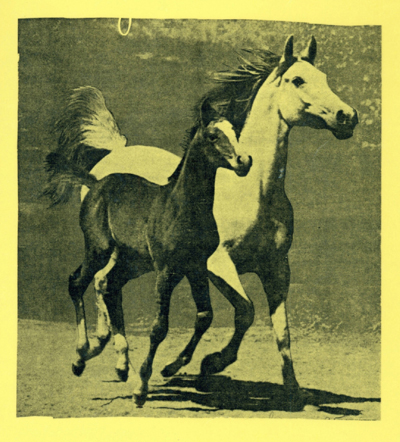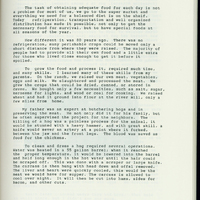023
Item
-
Title
-
023
-
Transcription
-
FOOD
The task of obtaining adequate food for each day is not a problem for most of us, we go to the super market and everything we need for a balanced diet is on the shelf. Today refrigeration, transportation and well organized distribution has made it possible, not only to get the necessary food for survival, but to have special foods at all seasons of the year.
How different it was 80 years ago. There was no refrigeration, many perishable crops could be moved only a short distance from where they were raised. The majority of people had to provide all their own food and a little extra for those who lived close enough to get it before it spoiled.
To grow the food and process it, required much time, and many skills. I learned many of these skills from my parents. On the ranch, we raised our own meat, vegetables, eggs and milk. We slaughtered and processed the meat. We grew the crops that could be dried, canned, or stored in caves. We bought only a few necessities, such as salt, sugar, kerosene for lights, and wood or coal for cooking. We raised wheat and had it ground into flour at the river mill, only a few miles from home.
My father was an expert at butchering hogs and in preserving the meat. He not only did it for his family, but he often supervised the project for the neighbors. The killing of a hog was a painless process for the animal, it would be stunned with a heavy hammer, and with great skill, a knife would sever an artery at a point where it forked, between the jaw and the front legs. The blood was saved as food for the chickens.
To clean and dress a hog required several operations. Water was heated in a 55 gallon barrel; when it reached the proper temperature, it would be lowered into the barrel and held long enough in the hot water until the hair could be scraped off. This was done with a scraper or large knife. The carcass is then hung with head down and offal removed. The liver and heart were quickly cooled, this would be the meat we would have for supper. The carcass is allowed to cool over night. It will then be cut into hams, sides for bacon, and other cuts.
-
Rights
-
To inquire about usage, please contact Archives & Special Collections, University of Nebraska-Lincoln Libraries. These images are for educational use only. Not all images are available for publication.
 Metzger Memories
Metzger Memories


